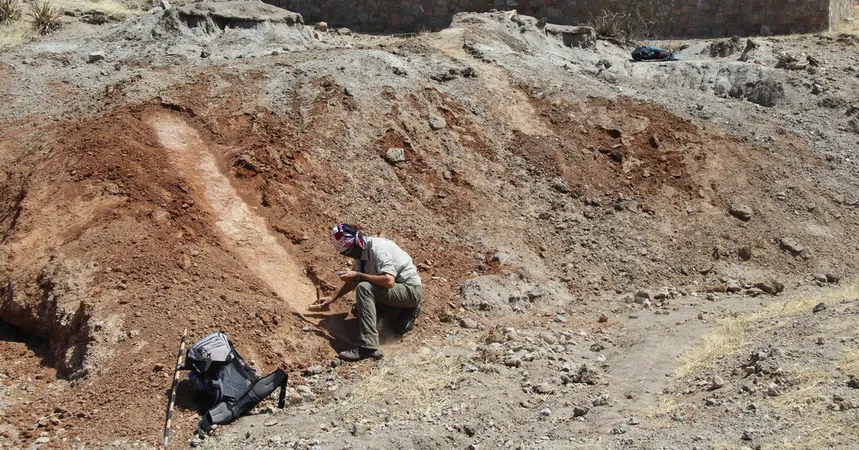
Discovering the Secrets of Our Extinct Relatives: How Homo Erectus Survived in Brutal Deserts!
2025-01-21
Author: Chun
Introduction
In a groundbreaking revelation, researchers have discovered that our ancient relatives, Homo erectus, thrived in extreme desert environments long before Homo sapiens made their mark on the Earth. While modern humans are often hailed as the ultimate survivors, a study recently published in the journal *Communications Earth and Environment* sheds light on the impressive adaptability of these early hominins.
Challenging the Prevailing Viewpoint
Fossils collected over many years indicated that early hominins primarily inhabited more hospitable woodlands. However, the study, led by archaeologist Julio Mercader from the University of Calgary, challenges this viewpoint by revealing that Homo erectus not only lived in but thrived in a harsh desert landscape situated in northern Tanzania, specifically at a site known as Engaji Nanyori.
Evolutionary Advancements
Homo erectus, which appeared about 2 million years ago, features crucial evolutionary advancements including taller stature and larger brains than their predecessors, though still smaller than those of modern humans. They are believed to have ventured out of Africa, reaching regions as far as Indonesia before their extinction approximately 100,000 years ago.
Environmental Analysis at Engaji Nanyori
The research team meticulously analyzed fossil pollen, rock chemistry, and other environmental traces to reconstruct the conditions prevailing at Engaji Nanyori. While the area was once lush open woodland, around one million years ago it transformed into a stark desert shrubland reminiscent of the Mojave. This provoked an intriguing question: How did Homo erectus manage to endure such a harsh climate?
Remarkable Adaptability of Homo Erectus
Rather than retreating, these early humans exhibited remarkable adaptability. They honed their scavenging techniques, locating temporary water sources formed by rainstorms, which attracted both animals and their hunters. This ingenuity allowed them to capitalize on fleeting opportunities in their environment.
Moreover, Homo erectus also refined their tool-making skills, meticulously crafting sharper edges from selected stones rather than haphazardly using whatever was nearby. This foresight led them to carry useful tools, anticipating future needs and enhancing their hunting efficacy.
Contributions to Human Expansion
The study indicates that the adaptability displayed by Homo erectus at Engaji Nanyori might have contributed significantly to their expansion across continents. In a world that was constantly changing, these ancient humans developed strategies that ensured their survival against the odds.
Echoes of Other Research
Interestingly, this research echoes findings from other studies, including work by Dr. Zeller, which utilize large-scale climate modeling to propose that early hominins might have thrived in conditions previously deemed too harsh for survival. As more evidence emerges, it becomes increasingly evident that the resilience and adaptability of our ancestors are qualities worthy of celebration.
Rethinking Human Evolution
This new understanding invites us to rethink the narrative of human evolution. Rather than portraying Homo sapiens as uniquely adaptable, it's clear that our predecessors faced extreme challenges and triumphed—proving that the roots of human resilience extend much deeper into our shared evolutionary past. Who knew that the key to understanding our own survival lay in the desert sands inhabited by Homo erectus?




 Brasil (PT)
Brasil (PT)
 Canada (EN)
Canada (EN)
 Chile (ES)
Chile (ES)
 Česko (CS)
Česko (CS)
 대한민국 (KO)
대한민국 (KO)
 España (ES)
España (ES)
 France (FR)
France (FR)
 Hong Kong (EN)
Hong Kong (EN)
 Italia (IT)
Italia (IT)
 日本 (JA)
日本 (JA)
 Magyarország (HU)
Magyarország (HU)
 Norge (NO)
Norge (NO)
 Polska (PL)
Polska (PL)
 Schweiz (DE)
Schweiz (DE)
 Singapore (EN)
Singapore (EN)
 Sverige (SV)
Sverige (SV)
 Suomi (FI)
Suomi (FI)
 Türkiye (TR)
Türkiye (TR)
 الإمارات العربية المتحدة (AR)
الإمارات العربية المتحدة (AR)